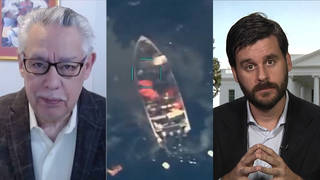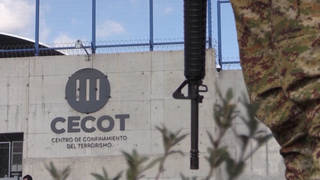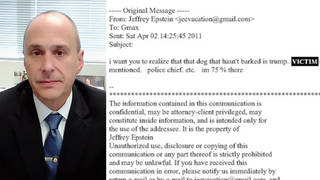
On Saturday in North Dakota, security guards working for the Dakota Access pipeline company attacked Native Americans with dogs and pepper spray as they resisted the $3.8 billion pipeline’s construction. If completed, the Dakota Access pipeline would carry about 500,000 barrels of crude per day from North Dakota’s Bakken oil field to Illinois, where it would meet up with an existing pipeline that would carry the oil all the way down to Texas. The pipeline has faced months of resistance from the Standing Rock Sioux Tribe and members of nearly 100 more tribes from across the U.S. and Canada. On Friday, lawyers for the tribe filed documents showing how the very land where Dakota Access would bulldoze on Saturday was, in fact, a tribal burial site. Democracy Now! was on the ground on Saturday, and we bring you this exclusive report.
Transcript
AMY GOODMAN: On Saturday in South Dakota, security guards working for the—in North Dakota, security guards working for the Dakota Access pipeline company attacked Native Americans with dogs and pepper spray as they resisted the $3.8 billion pipeline’s construction. If completed, the Dakota Access pipeline would carry about 500,000 barrels of crude per day from North Dakota’s Bakken oil field to Illinois, where it would meet up with an existing pipeline that would carry the oil all the way down to Texas.
The pipeline has faced months of resistance from the Standing Rock Sioux Tribe and members of nearly 100 more tribes from across the U.S. and Canada. The Standing Rock Sioux Tribe has also sued the U.S. government over the pipeline’s construction. On Friday, lawyers for the tribe filed documents showing how the very land where Dakota Access would bulldoze Saturday was, in fact, a tribal burial site. On Sunday, more than 500 people marched back to the construction site and held a prayer, mourning the destruction of their ancestors’ graves.
Today, a federal judge in Washington, D.C., will decide whether to grant a temporary restraining order prohibiting further construction of the Dakota Access pipeline in the area near the Standing Rock Sioux reservation, until this same judge rules on an injunction in the tribe’s lawsuit against the U.S. government, which is expected by Friday.
Well, Democracy Now! was on the ground Saturday. We bring you this exclusive report.
WATER PROTECTOR 1: Criminals! You guys are criminals! Go get your money somewhere else!
WATER PROTECTOR 2: Yeah, you! Yeah, you!
AMY GOODMAN: We’re standing at the construction site of the Dakota Access pipeline. It looks like there are at least three bulldozers that are, to people’s surprise, at this moment, actually bulldozing the land. There’s a helicopter above. There’s security here. And hundreds of people have been marching up, when they heard that the construction site is actually active right now.
WATER PROTECTOR 3: It’s not too late to go home!
WATER PROTECTOR 4: Yeah, that’s what you’re doing to it!
WATER PROTECTOR 5: You’re raping our mother!
WATER PROTECTOR 3: It’s not too late to go home! Think of your children!
WATER PROTECTOR 4: Where are we going to live without this [inaudible]?
JACOB JOHNS: My name is Jacob, Jacob Johns.
AMY GOODMAN: And where are you from?
JACOB JOHNS: I’m from Spokane, Washington. I’m Hopi and Akimel O’Odham.
AMY GOODMAN: And can you describe what you see, what they’re doing?
JACOB JOHNS: They are—they’re bulldozing. They’re bulldozing and preparing to put in—install a pipeline to go into the—deep in the river.
AMY GOODMAN: And above, we see a helicopter.
JACOB JOHNS: The helicopter itself has been following us and taking pictures. And we’re filming them in return.
WATER PROTECTOR 6: Come on, guys! We’ve got to stop this!
LINDA LEE BRUNER: Why are we standing and watching? Get out there! Stop this! Why are we standing and watching and taking pictures? Let’s go!
AMY GOODMAN: People have gone through the fence—men, women and children. The bulldozers are still going. And they’re yelling at the men in hard hats. One man in a hard hat threw one of the protesters down. And they’re marching over the dirt mounds. Some of the security have dogs.
The six bulldozers are pulling back right now. People are marching forward in their tracks. There are men, women and children. More security trucks are pulling up. There are some protesters on horseback. Hundreds of people are coming from the main camp. They’re climbing up the tracks left by the bulldozers—six, at least, I’ve counted, that are now receding.
Protesters advance as far as a small wooden bridge. Security unleashes one of the dogs, which attacks two of the Native Americans’ horses.
Security has some kind of gas. People are being pepper-sprayed.
WATER PROTECTORS: We are not leaving! We are not leaving! We are not leaving! We are not leaving! We are not leaving! We are not leaving! We are not leaving! We are not leaving! We are not leaving!
AMY GOODMAN: Sir, reporter from New York. What are you spraying people with?
SECURITY MAN: I didn’t spray anything, ma’am.
AMY GOODMAN: But what is that?
WATER PROTECTOR 7: This guy just maced me in the face right now. Amy Goodman, this guy maced me in the face.
LAURA GOTTESDIENER: Why don’t—can you show us the label?
WATER PROTECTOR 7: Look, it’s all over my sunglasses. Just maced me in the face. Dog bit him right now.
VICTOR PUERTAS: Throwed the dog on me. This [bleep] throwed the dog on me. Look at this. Look at this. You throwed the dog on me. No, you did it on purpose, man.
AMY GOODMAN: Let me see. Let me see.
VICTOR PUERTAS: Over there, with that dog. I was like walking. Throwed the dog on me and straight, even without any warning. You know? Look at this. Look at this.
AMY GOODMAN: That dog bit you?
VICTOR PUERTAS: Yeah, the dog did it, you know? Look at this. It’s there. It’s all bleeding.
AMY GOODMAN: Ma’am, your dog just bit this protester. Your dog just bit that protester. Are you telling the dogs to bite the protesters?
WATER PROTECTOR 8: She keeps sicking them after people.
AMY GOODMAN: The dog has blood in its nose and its mouth.
WATER PROTECTOR 8: And she’s still standing here threatening us.
WATER PROTECTOR 9: You can’t put the blame on your dog. You’re an evil woman.
WATER PROTECTOR 8: That’s mistreatment against your own animal.
WATER PROTECTOR 9: You can’t put your blame on the [bleep] dog. You’re evil.
WATER PROTECTOR 8: That’s mistreatment against your own animal.
WATER PROTECTOR 9: You will live with that.
WATER PROTECTOR 10: Get the [bleep] out of here!
WATER PROTECTOR 8: These people are just threatening all of us with these dogs. And she, that woman over there, she was charging, and it bit somebody right in the face. And then it charged at me and tried to bite me. And she’s still—they’re still threatening those dogs against us. And we’re not doing anything.
AMY GOODMAN: Why are you letting their—her dog go after the protesters? It’s covered in blood!
WATER PROTECTOR 11: Stop!
AMY GOODMAN: One of the pipeline’s security men unleashes a dog into the crowd.
WATER PROTECTOR 12: What the [bleep] are you trying to do?
WATER PROTECTOR 13: Get your [bleep] dogs [bleep] out of here! Get your [bleep] dogs out of here!
AMY GOODMAN: Protesters respond using a flagpole and sticks to fend off the dog attacks.
WATER PROTECTOR 12: Get the [bleep] out! Get out! Get the [bleep] out!
WATER PROTECTOR 14: We ain’t scared of you! We ain’t scared of you! Mother [bleep]!
WATER PROTECTOR 15: What’s the [bleep] your dog gonna do?
WATER PROTECTOR 12: Get the [bleep] out! Get the [bleep] out!
WATER PROTECTOR 16: Let them leave!
AMY GOODMAN: After the protesters said that the dog was bloody from biting them, they then pulled the dogs away, and now pickup truck by pickup truck is pulling away. We’ll see what happens. The protesters are moving in to ensure that the security leaves. Let’s go check on this woman. What happened?
REYNA CROW: Just a lot of mace, and the sweat was dripping it into—it was—the sweat was making it run down into my eyes. I had my glasses on, and that spared me the brunt of it, but then the sweat started putting it in.
AMY GOODMAN: How are you doing?
REYNA CROW: I’m great!
AMY GOODMAN: What’s your name?
REYNA CROW: Reyna Crow.
AMY GOODMAN: And what do you think you’ve accomplished today?
REYNA CROW: I hope we’ve accomplished letting Enbridge know that the people of this nation and the people of this world, tribal or otherwise, have withdrawn their social license to pollute water, and that they need to find an honest, nonviolent way to make a living.
AMY GOODMAN: Where are you from?
REYNA CROW: Duluth, Minnesota. Idle No More Duluth.
WATER PROTECTOR 17: I got maced twice. I got bit by a dog. I was the front line.
AMY GOODMAN: Where did you get bit?
WATER PROTECTOR 17: I got bit on the ankle, where my boot is. So, I told them they needed to leave, but the guy didn’t believe me. So he didn’t want to listen. He stuck his hand out, and he maced me, this other guy, and I think he maced a lady, too. Then they tried getting the dogs on us. I was just standing there, wasn’t really doing nothing. That dog ran up on me, and it bit my—around my ankle.
AMY GOODMAN: You pushed them back, though?
WATER PROTECTOR 17: Yes.
AMY GOODMAN: Why is this such an important fight to you?
WATER PROTECTOR 17: Because water is life. Like I said, without water, we’d all—we wouldn’t be here. These plants wouldn’t be here. There’d be no oxygen. We’d all die without it. I wish they’d open their eyes and have a heart, to realize, you know, if this happens, we’re not going to be the only ones that are going to suffer. They’re going to suffer, too.
AMY GOODMAN: What tribe are you with?
WATER PROTECTOR 17: I’m Oglala Sioux, full blood.
AMY GOODMAN: From?
WATER PROTECTOR 17: Pine Ridge Reservation.
AMY GOODMAN: What’s your name, and where are you from?
LINDA LEE BRUNER: Linda Lee Bruner. I’m from Belcourt, North Dakota. I’ve traveled from Wichita, Kansas. I stand for my grandchildren, my next grandchildren. I already got great-grandchildren that are in the future. I know the 18-year-old and 19-year-olds that are getting ready to come here, they’ll fight to the end. We’re going to stay here, just like in 1836. We’re going to go down and wait and wait. This oil ain’t gonna go through.
WATER PROTECTOR 18: We should all walk out together. That’s a good idea, whoever said that.
ELVIA RAMIREZ: I am Elvia Ramirez. I come from Arizona, Salt River. I’m in Pima-Maricopa Tribe.
AMY GOODMAN: How old are you?
ELVIA RAMIREZ: I am 13 years old.
AMY GOODMAN: And why are you out here today?
ELVIA RAMIREZ: I am with my family, because I believe—I hear what they’re doing is wrong. This is very wrong. They should protect the water. Everybody needs water to live. Water is in us. NAWA.
AMY GOODMAN: What about the oil?
ELVIA RAMIREZ: The oil should stay in the ground. They should just leave it, because they’re hurting Mother Nature. Mother Nature is important, because without Mother Nature, we wouldn’t be here.
WATER PROTECTOR 19: No one owns this land. This land belongs to the Earth. We are only caretakers. We’re caretakers of the Earth.
AMY GOODMAN: Do you feel like you won today?
WATER PROTECTOR 19: We win every day when we stand in unity. We stand, and we fight.
KANDI MOSSETT: My name is Kandi Mossett with the Indigenous Environmental Network.
AMY GOODMAN: Is this where the DAPL is being built?
KANDI MOSSETT: Yes, this is the pipe that is leading up to the river. So what we’re waiting for—or, what Dakota Access is waiting for is the easement to go underneath and bore under the water. My understanding was that with the TRO, they were supposed to completely quit construction. But I guess, in the oil and gas industry, that’s not the way it works.
AMY GOODMAN: The temporary restraining order.
KANDI MOSSETT: Right. Well, there was a restraining order, and they were supposed to, I thought, we all thought, stop construction completely. But they’ve been coming from the west, over here, this whole time, these past three weeks, ever since you saw the first demonstrations. And obviously, now, this is how close they are, right across the road from where we’ve been barricading. So they’re continuing to lay pipe up to the point of where they’re waiting for the easement to go underneath where they’re going to bore. So people are like, “Why are we going to wait for that? We’re not. We’re going to go out, and we’re going to stop the pipeline. We’re going to stop it where it is.” And that’s what effectively has been happening the past few days in nonviolent direct action.
AMY GOODMAN: How do you feel?
WATER PROTECTOR 20: Feel great.
AMY GOODMAN: What did you accomplish today?
WATER PROTECTOR 20: We’re protecting our water. That’s what we’re here to do, and that’s what we did.
AMY GOODMAN: Where are your horses from?
WATER PROTECTOR 20: Crow Creek, South Dakota.
AMY GOODMAN: And you came from there?
WATER PROTECTOR 20: Yes, ma’am.
AMY GOODMAN: And so, describe the scene to us.
WATER PROTECTOR 20: We protected our water, and we did a good job at doing it. Thank you.
AMY GOODMAN: Thank you. Thank you.
AMY GOODMAN: Voices from the standoff at Standing Rock in North Dakota. That report produced with Laura Gottesdiener, John Hamilton and Denis Moynihan. For our radio audience, go to democracynow.org to see this exclusive video. Coming up, we’ll go to North Dakota to speak with the Standing Rock Sioux Tribe chairman and to D.C. to speak with the tribe’s lawyer, who’s going to federal court today seeking an emergency restraining order against the pipeline’s construction. This is Democracy Now! We’ll be back in a minute.












Media Options